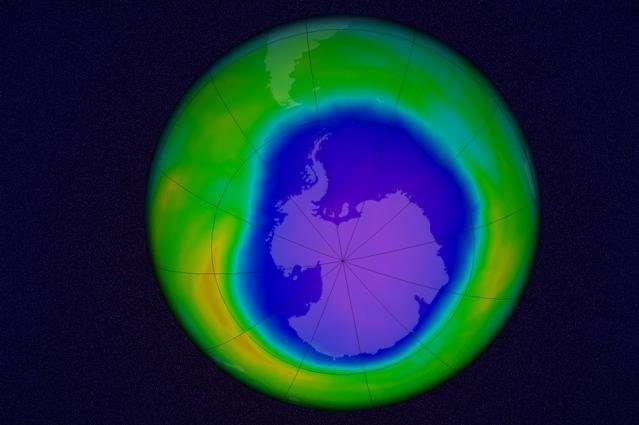A rendering shows the Antarctic ozone hole at its peak last fall, based on measurements made on October 22, 2015. Photo by NASA/Goddard Space Flight Center
BOSTON, June 30 (UPI) -- In a new report published in the journal Science, MIT scientists have documented the "first fingerprints of healing" in the ozone layer above Antarctica.
"We can now be confident that the things we've done have put the planet on a path to heal," reseacher Susan Solomon, lead author of the new report and a professor of atmospheric chemistry and climate science at MIT, said in a news release.
Though, as the new research shows, the recovery has slowed at times as a result of volcanic eruptions, the hole in the ozone has continued to shrink since 2000. Over the last 16 years, the hole has shrunk some 4 million square kilometers, or 1.5 square miles.
For the first time, scientists were able to point directly to changes in the chemical composition of the ozone as a result in the reduction of atmospheric chlorine originating from chlorofluorocarbons -- "fingerprints of healing."
Chlorofluorocarbons, or CFCs, were once leaked into the atmosphere by dry cleaners, aging refrigerators and aerosols, but the 1987 Montreal Protocol saw almost the entire developed world agree to cease their use.
The size of the hole in the ozone fluctuates throughout the year, as chlorine can only eat away at ozone molecules when sunlight is present and temperatures are cold. The hole is at its largest in October, which is when scientists have mostly studied it.
But the latest research effort focused on the hole's behavior during September when it is just beginning to expand.
"I think people, myself included, had been too focused on October, because that's when the ozone hole is enormous, in its full glory," Solomon explained. "But October is also subject to the slings and arrows of other things that vary, like slight changes in meteorology. September is a better time to look because chlorine chemistry is firmly in control of the rate at which the hole forms at that time of year. That point hasn't really been made strongly in the past."
Scientists measured the size of the hole and the changing chemical conditions using weather balloons and satellites. They also built a model to predict the hole's evolution based solely on the diminishing chlorine levels in the atmosphere.
The simulation featured predictions mostly in line with the scientists' direct measurements. The congruity suggests the majority of the ozone's healing is the result of Montreal Protocol.
"What's exciting for me personally is, this brings so much of my own work over 30 years full circle," said Solomon, whose science was used to inspire consensus during negotiations surrounding the Montreal Protocol.
"Science was helpful in showing the path, diplomats and countries and industry were incredibly able in charting a pathway out of these molecules, and now we've actually seen the planet starting to get better," Solomon concluded. "It's a wonderful thing."















